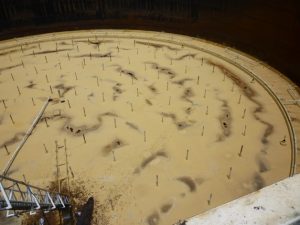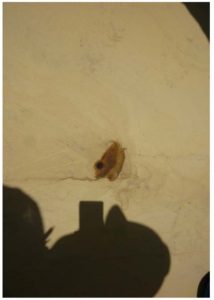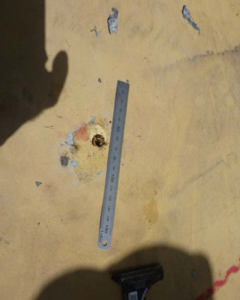Polyurea Disaster is a Learning Experience

Floating tank lid
In 2012, was called on a polyurea coating “issue” at an old refinery located in the Caribbean Islands. A polyurea coating system had been applied to the top of a floating tank lid due to corrosion and perforations. This allowed oil and vapors to permeate through and rainwater to infiltrate into the tank. After the application, it was reported that “oil” was still oozing through the applied polyurea and was ponding on the top floating tank lid. It could be that the polyurea was either applied to thin, or there was pin-holing present in the applied polyurea coating. These storage tanks were 235 and 265 feet (~72 and 81 meters) in diameter, representing 43,350 and 55,540 ft2 (~4,030 and 5,160 m2) respectively in surface area coated.
Upon inspection, it was found that the polyurea had been applied at well over 80 mils (2 mm), with some areas at 120 mils (3 mm) plus, and no pin-holing was noted in the uniform application. However, it was found that after cleaning at the various “ponding” locations, someone onsite personnel had later drilled holes through the polyurea/tank lid!!!! Yes, it’s true! They said they did this as water was staring to build on the tank roof lid and needed the water to drain through! So, that is on the facility owner! But it gets worse……


For one of the tanks lid application, the applied polyurea was separating easily between application layers, a notation was that a bottom/first layer of the polyurea (about 20 mils, 500 µm) was separating from the main thickness of polyurea material. It was reported that during the application work, they applied a “primer coat”/first layer of the polyurea (~20 mils / 500µm) during the blasting process to the complete surface area. After all the prep and “primer” coat was completed, and additional 80+ mils (2 mm) of polyurea was applied. It was asked what surface preparation had been done to the initial application, before adding the second layer, as several weeks had elapsed. The response – NONE!!
This was “justified” on their part, as in the bid documentation, they used a polyurea that had an extended the re-coat window (re-bonding capability), and is quoted from the documentation:
“…application of the “Polyurea” also enhances adhesive quality allowing it to adhere better to a variety of substrates and recoat itself without additional prep for up to 6 months” ….. section from proposal specification.
WHAT?????
They were reminded that this was an outdoor/exterior application, on an island, next to the salt water coast, with daily wind-blown contamination, as well as frequent rains….. Polyurea systems are not really surface-tolerant coating systems, and just because the system has a reported extended re-coat/over-coat window, you still have to prepare the surface to remove any contaminants that would have been deposited between application work.
So, that is on the contractor/applicator!
This is a true story! You just can’t make this up if you tried.
Primeaux Associates, LLC.
dj.primeauxii@gmail.com
dudley@primeauxassociates.com
www.primeauxassociates.com





